
Wilhelm Benque (1843-1903) was a French portrait photographer of German origin, belonging to an important dynasty of photographers, the Benques.

Wilhelm Benque (1843-1903) was a French portrait photographer of German origin, belonging to an important dynasty of photographers, the Benques.
Wilhelm Benque, known as "the Younger", descended from a family from Ludwigslust (Mecklenburg, Germany). His uncle, the landscape designer Wilhelm Friedrich Alexander Benque (1814-1895), had a younger brother, Christian Benque (1811-1883) whose son, Franz Benque (1841-1921) became a photographer, first in Hamburg (1869-1870), then in Brazil (from 1878) before finally settling in Trieste. From the 1880s onwards, the Benques represented a dynasty of photographers, with a presence on three continents. When Wilhelm Benque arrived in Paris, he was associated with one of the members of the Benque family, Franz Wilhelm Benque (1857-1912), son of the landscape photographer Wilhelm Benque. [1]
In the 1880s and 1890s, the Benques established their studio in Paris at 33, rue Boissy-d'Anglas under the name Benque, Benque et Cie. A successful venture, they occupied a private mansion at this address, targeted a luxury clientele, and even opened an exhibition store at 5 rue Royale.
In the meantime, the company joined forces with two other photographers, named Klary (?-?) and Kneubuhler (1816-1880), and the name became Benque & Klary for a time until it was taken over by Matuszewski after 1902.
The Benques also opened a second studio in Nice around 1883-1884.
Benque was particularly active with personalities linked to the world of opera and the Parisian stage. They took well-known photographs of Louise Abbéma, Valentin Duc, Eleonora Duse and Cléopâtre-Diane de Mérode when she was promoted to "grand sujet" among the ballerinas in 1896. [2]
The Benque studios enjoyed an international reputation by the end of the 19th century. [3]

Wilhelm Iwan Friederich August von Gloeden, commonly known as Baron von Gloeden, was a German photographer who worked mainly in Italy. He is mostly known for his pastoral nude studies of Sicilian boys, which usually featured props such as wreaths or amphoras, suggesting a setting in the Greece or Italy of antiquity. His work demonstrates the controlled use of lighting as well utilizing elegant poses of his models. His innovations include the use of photographic filters and special body makeup to disguise skin blemishes. His work, both landscapes and nudes, drew wealthy tourists to Sicily, particularly gay men uncomfortable in northern Europe.

Riedel Crystal is a glassware manufacturer based in Kufstein, Austria, best known for its glassware designed to enhance different types of wines. According to Petr Novy, Chief curator Museum of Glass and Jewellery in Jablonec nad Nisou, Czech Republic, Riedel is the oldest family owned and operated global crystal glass brand worldwide. Established in Bohemia in 1756, the company is managed by Georg Riedel and Maximilian Riedel. Later, it was re-established by Claus J. Riedel in 1956, with the support of the Swarovski family.

Carl Joseph Begas, or Karl Begas, was a German painter who played an important role in the transition from Romanticism to Realism. He was the first in a multi-generational "dynasty" of artists.
Maison Bonfils was a French family-run company producing and selling photography and photographic products from Beirut from 1867 until 1918, from 1878 on renamed "F. Bonfils et Cie". The Bonfils ran the first and, in their time, most successful photographic studio in the city. Maison Bonfils produced studio portraits, staged biblical scenes, landscapes, and panoramic photographs.
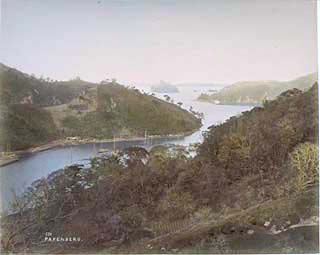
The firm of Stillfried & Andersen, also known as the Japan Photographic Association, was a photographic studio founded by Baron Raimund von Stillfried and Hermann Andersen that operated in Yokohama, Japan between 1876 and 1885. The studio is noted for its portraits and landscapes that were often hand-coloured and presented in bound albums. The firm also produced photographic prints from negatives by Felice Beato.

Paul Durand-Ruel was a French art dealer associated with the Impressionists and the Barbizon School. Being the first to support artists such as Claude Monet, Camille Pissarro, and Pierre-Auguste Renoir, he is known for his innovations in modernizing art markets, and is generally considered to be the most important art dealer of the 19th century. An ambitious entrepreneur, Durand-Ruel cultivated international interest in French artists by establishing art galleries and exhibitions in London, New York, Berlin, Brussels, among other places. Additionally, he played a role in the decentralization of art markets in France, which prior to the mid-19th century was monopolized by the Salon system.
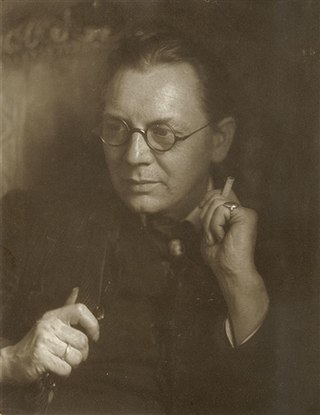
Hugo Erfurth was a German photographer known for his portraits of celebrities and cultural figures of the early twentieth century.
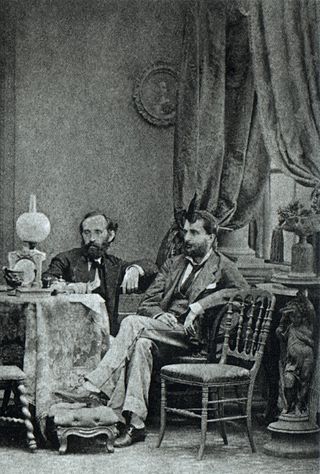
Alberto Henschel was a German-born Brazilian photographer born in Berlin. Considered the hardest-working photographer and businessman in 19th-century Brazil, with offices in Pernambuco, Bahia, Rio de Janeiro, and São Paulo, Henschel was also responsible for the presence of other professional photographers in the country, including his compatriot Karl Ernst Papf—with whom he later worked.
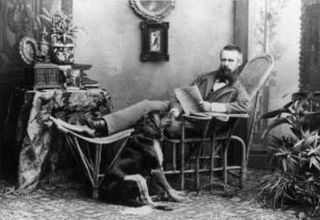
Franz Benque, known in Brazil as Francisco Benque, was a German photographer.
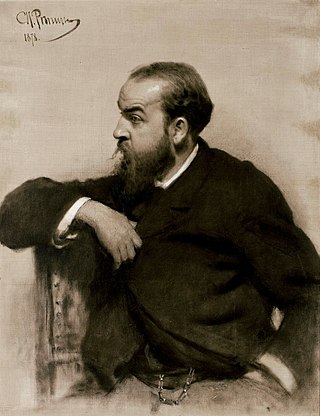
Rafail Sergeevich Levitsky was a Russian and Soviet genre, romantic, and impressionist artist who was an active participant in the Peredvizhniki (Itinerant) Movement.
Theodore Scott-Dabo casually known as Scott Dabo, was a French/American tonalist landscape artist thought to be originally from Detroit, Michigan but now known to have been born in Saverne, France. Active both in New York and Paris, he was the younger brother of Leon Dabo. Both artists were Impressionist landscape painters, who shared in a similar manner in style and tone. During the period when they worked together, their subjects were usually landscapes and seascapes in the early morning or evening at twilight, they utilized spare composition and reductive color schemes to evoke what they termed, mood. The Dabo brothers style that had a Whistlerian quality, and like James McNeill Whistler both would come to be labeled Tonalist. The youngest brother in the family, Louis, a writer and publicist, also used the name Scott Dabo.
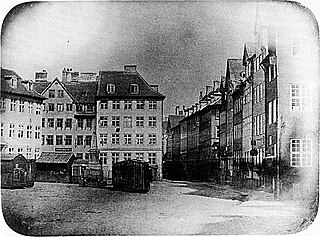
In Denmark, photography has developed from strong participation and interest in the very beginnings of the art in 1839 to the success of a considerable number of Danes in the world of photography today.
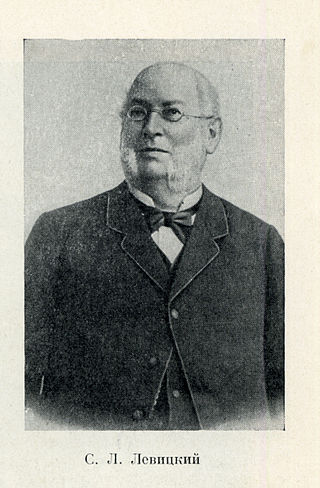
Count Sergei Lvovich Levitsky, is considered one of the patriarchs of Russian photography and one of Europe's most important early photographic pioneers, inventors and innovators.
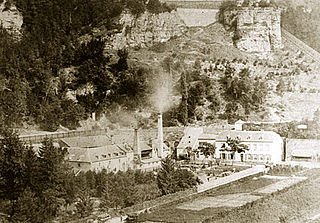
Photography in Luxembourg is often associated with two figures who were born in Luxembourg but left when very young: Edward Steichen (1879–1973) was an American who made outstanding contributions to fashion and military photography during the first half of the 20th century; while Gabriel Lippmann (1845–1921), a Frenchman, was awarded the Nobel prize in physics for his achievements in colour photography. There are however many Luxembourg nationals who are remembered for recording the development of the city of Luxembourg and the country as a whole from the 1850s to the present.

Jean Adolphe Braun was a French photographer, best known for his floral still lifes, Parisian street scenes, and grand Alpine landscapes.

Sasha Stone, born Aleksander Steinsapir was a Russian artist. A stateless photographer, he and his first wife, Cami Stone, were successful photographers during the 1920s and 1930s. One of his best-known works is the photomontage he designed for the cover of Walter Benjamin's Einbahnstraße published in 1928.

Marubi National Museum of Photography , also known as Marubi Museum, is a museum in Shkodër, Albania.

Wilhelm Dürr the Younger was a German painter and draughtsman, as well as a professor at the Academy of Fine Arts in Munich.

The history of photography in Albania begins with the Marubi Dynasty and its founder Pietro Marubi (1834–1903), who settled in the northwestern city of Shkodër from Piacenza, Italy during the second half of the nineteenth century and opened the first photography studio there in 1858. Having no children of his own, Marubi's first assistants and faithful successors were Mati and Kel Kodheli, the sons of his gardener Rrok Kodheli. Pietro sent Mati, the elder of the two brothers, to study photography at the Sebastianutti & Benque studio in Trieste. When Mati died prematurely at age nineteen, in 1881, Pietro adopted Kel, whom he also sent to Italy to study and who would later assume the surname Marubi. Upon Pietro's death in 1903, Kel inherited his adopted father's studio and continued its work. He, in turn, was followed into business by his own son, Geg Marubi, who studied photography and cinematography in France at the Lumière brothers’ studio.
Hermann Linde was a German pharmacist and early photographer. He is generally referred to as The Elder to distinguish him from his son, Hermann, who was a painter.
![]() Media related to Wilhelm Benque at Wikimedia Commons
Media related to Wilhelm Benque at Wikimedia Commons